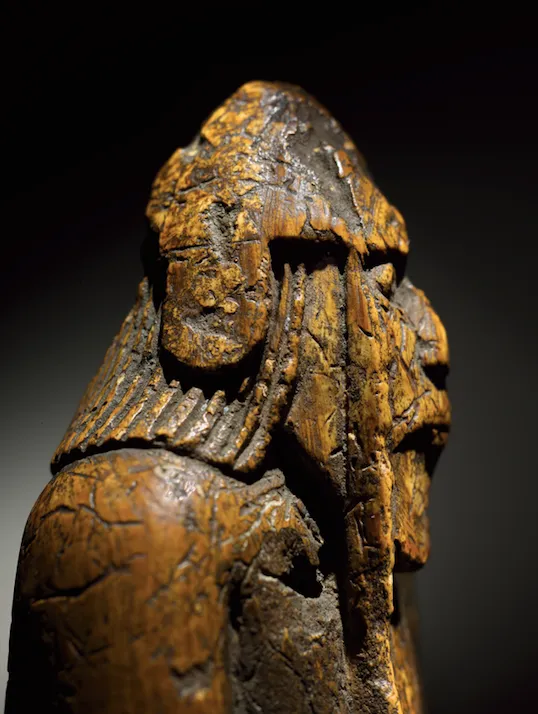A Medieval Chess Piece Potentially Worth $1.2 Million Languished in a Drawer for Decades
The Lewis warder, part of a larger trove of 12th-century ivory chessmen, was purchased for £5 in 1964
/https://tf-cmsv2-smithsonianmag-media.s3.amazonaws.com/filer/41/b5/41b51b7c-381b-4693-97bb-196cbe572b8e/a_lewis_chessman_9.jpg)
In 1964, an antiques dealer from Edinburgh, Scotland, spent £5—roughly £100, or $125 USD, in today’s money—on an ivory figurine he later catalogued in his purchase ledger as an “Antique Walrus Tusk Warrior Chessman.” Following the anonymous dealer’s death, the 3.5-inch standing soldier passed down to his daughter, who stored it in a drawer for the next several decades, unaware that she was in possession of a rare piece from arguably the most famous chess set in history.
Recovered from a sand dune on Scotland’s Isle of Lewis in 1831, the Lewis Chessmen, were part of a hoard of 93 artifacts, including 78 seated kings and queens, bishops, knights, standing warders (the equivalent to a modern-day rook or castle), and pawns; 14 “tablemen” pieces similar to those used in backgammon; and one buckle. Together, they testify to the region’s historic ties with Norway, which controlled Scotland’s Outer Hebrides at the time of the pieces’ creation, and represent one of the most well-preserved examples of medieval European chess sets.
Although the chess pieces form almost four complete sets, BBC News points out that the group is missing one knight and four warders. The Edinburgh piece, which represents one of the warders, was carved out of walrus tusk ivory to depict a fierce bearded warrior wielding both sword and shield. It is the first of these five missing pieces to materialize.
The warder is set to be sold by Sotheby’s on July 2, with the lot’s current estimate at £600,000 to £1 million, or $760,000 to $1.2 million.

As Alex Horton writes for the Washington Post, the chess pieces were likely carved by artisans from the Norwegian settlement of Trondheim between 1150 and 1200. Eventually, the sets ended up buried beneath the sands of the Isle of Lewis, perhaps placed in safekeeping by a merchant traveling between Norway and Ireland or hidden by a trader after a shipwreck—a theory first posited by British Museum curator Frederic Madden shortly after the well-preserved hoard was found.
Madden’s account, as detailed in a blog post by the Metropolitan Museum of Art’s James Robinson, identifies four of the warders as Berserkers, intimidating figures from Norse mythology. These infantrymen are distinguished by what the Guardian’s Mark Brown describes as “an ecstasy of rage,” driving themselves into a self-induced craze by biting the tops of their shields.
Speaking with the Press Association, Sotheby’s Alexander Kader says the rediscovered chessman, who holds a shield in his left hand rather than gnawing on it in a frenzied battle ritual, is “a little bit bashed up.”
Kader, a European sculpture expert who authenticated the piece after its owners stopped by for evaluation, notes that the warder, which is not believed to represent a Berserker, “has lost its left eye. But that kind of weather-beaten, weary warrior added to its charm.”

The Lewis chessmen have achieved an almost mythical status in British culture: Ron, Harry and Hermione battle an enchanted version of the chess set in the 2001 film adaptation of Harry Potter and the Sorcerer’s Stone, while the Viking-esque world seen in the children’s television show “Noggin the Nog” was directly inspired by the chessmen. Eighty-two pieces from the original hoard are currently on view at the British Museum, where they are among the institution’s most cherished and well-traveled artifacts, and the other 11 are held in the National Museum of Scotland’s collection.
As Kader explains in a statement, much of the Edinburgh warder’s story is “still to be told.” It’s unknown how the chessman was separated from the rest of the set, where the figurine spent the hundreds of years leading up to the dealer’s 1964 purchase, and how, or if, the medieval rook is connected to the four still-missing pieces.
Despite the fact that the dealer and his descendants were unaware of their chessman’s provenance, a spokesperson says the family long admired its “intricacy and quirkiness.” The dealer’s daughter, who inherited the artifact after her father’s passing, “believed that it was special and thought perhaps it could even have had some magical significance. … From time to time, she would remove the chess piece from the drawer in order to appreciate its uniqueness.”
/https://tf-cmsv2-smithsonianmag-media.s3.amazonaws.com/accounts/headshot/mellon.png)
/https://tf-cmsv2-smithsonianmag-media.s3.amazonaws.com/accounts/headshot/mellon.png)